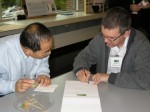Despite considerable research, earthquake dynamics remains one of the major challenges in geophysics. A recent workshop on Dynamics of Seismicity, Earthquake Clustering and Patterns in Fault Networks at SAMSI in Research Triangle Park, North Carolina, was organized to achieve progress in this field by taking advantage of newly available data sets and statistical techniques. The workshop was part of the international program “Mathematics of Planet Earth 2013” and was organized in cooperation with the Bernoulli Society for Mathematical Statistics and Probability via the Committee on Probability and Statistics in Physical Sciences and the International Union of Geodesy and Geophysics via the Commission on Mathematical Geophysics.
The main goal of the workshop was to build and strengthen emerging links between active research groups in different scientific areas—statistics, probability, mathematics, physics, seismology and computer science—toward achieving a solid understanding of seismicity patterns and structures and a physical theory for earthquake dynamics. The workshop highlighted the key role of the mathematical sciences in studying seismicity dynamics in relation to properties of faults and the Earth’s crust.
Quality and availability of seismic data was one of the workshop topics. Many studies of seismicity are based on regional or global earthquake catalogs. Regional seismic networks in the US usually produce these catalogs. The global ComCat catalog of USGS/ANSS is a merged version of all catalogs produced in the US, including the global NEIC catalog. Most seismic networks also produce real-time catalogs automatically, but these are usually of lesser quality than the human reviewed catalogs. As real-time catalogs improve and the cost of producing human reviewed catalogs increases, network operators and the researchers are faced with the questions if the real-time catalogs are sufficient. This question is particularly pressing in the current budget climate, which has already had a negative impact on catalog production. The real-time catalogs meet the need for rapid notification to emergency managers; however, they may not provide accurate count of small earthquakes, and in some cases magnitudes for events less than M3 may be incorrect or a few events may be mislocated. The research community that works with seismicity catalogs could provide minimum quality criteria for seismicity catalogs, which can be used to judge which catalogs are of sufficient quality to be used for seismicity research.
The workshop participants discussed several key topics related to earthquake dynamics: (i) State-of-the-art seismic data and its complexity (Egill Hauksson, Caltech, and Yehuda Ben-Zion, USC), (ii) Earthquake clustering and triggering (Zhigang Peng, Georgia Tech; Ilya Zaliapin, U of Nevada, Reno; and Joern Davidsen, U of Calgary), (iii) Statistical and mathematical modeling and forecasting (Antoinette Tordesilla, U of Melbourne; Bala Rajaratnam, Stanford; Philip Stark, UC Berkeley, Dave Harte, Statistical Research Associates, New Zealand; and Karin Dahmen, U of Illinois Urbana/Champaign).
Further information can be found at the workshop site.
Yehuda Ben-Zion, University of Southern California
Jörn Davidsen, University of Calgary
Egill Hauksson, California Institute of Technology
Ilya Zaliapin, University of Nevada, Reno

